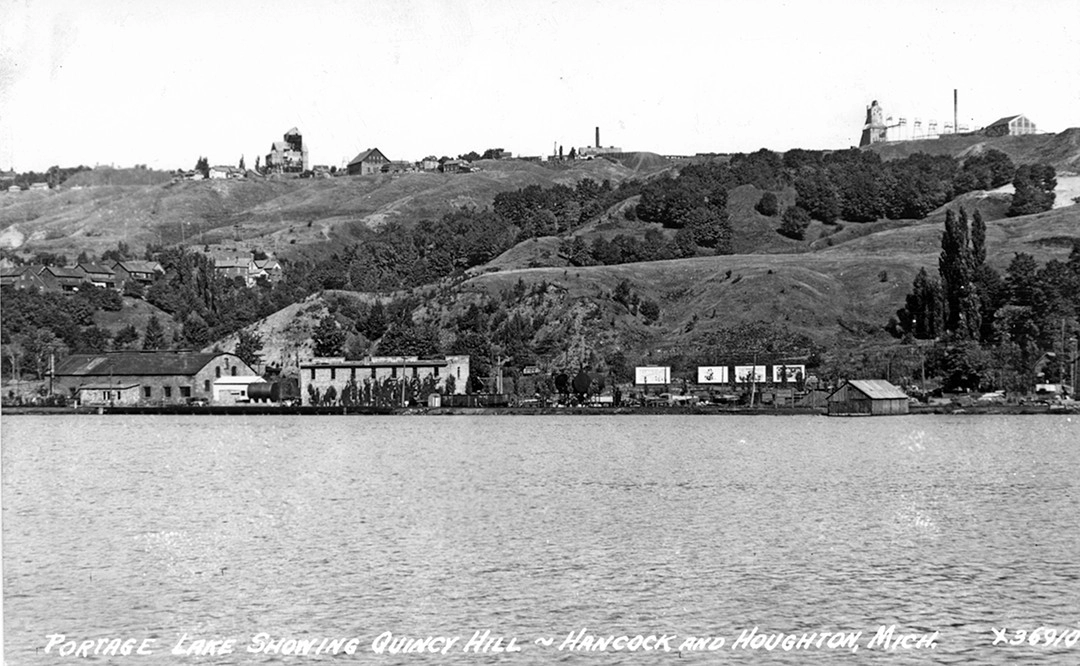- Details
- Hits: 2712
Mine: Quincy Mine, Hancock, MI
Began → Quincy Mine → Closed
Operated for 101 years.
From: 1846
Owned by: Quincy Mining Company
Produced: Copper Ore
Method: Underground mine shaft and adits.
Railroad connection: Quincy & Torch Lake, DSS&A.
Stamp Mill/Smelter: Ordinal Quincy Mill at Ripley, then Quincy Mining Company Stamp Mill; Quincy Smelter.
Until: 1945
Lifetime Production:
 Photo info: A view of Quincy Hill in Hancock (viewed from the Houghton side of Portage Lake) showing several shaft houses and building at the mine in the 1930's. [Reid Van Sluys collection]
Photo info: A view of Quincy Hill in Hancock (viewed from the Houghton side of Portage Lake) showing several shaft houses and building at the mine in the 1930's. [Reid Van Sluys collection]
Notes
Quincy Mine was established up the hill from the City of Hancock about 1856. It had five shafts and was a long producing and profitable copper mine. The mining company had a hillside tram road to take rock to their original stamp mill on Portage Lake in Hancock. It later built its own narrow gauge railroad (the Quincy & Torch Lake) to take aggregate to their new stamping mill near Hubbell on Torch Lake.
Roundhouse. The roundhouse was initially built in 1890 along with the Quincy & Torch Lake Railroad, linking the mines with the stamping plant on Torch Lake. It originally has two stalls, 64' in length. A third stall was added in 1894 and a fourth in 1900. [UPM]
Shaft No. 2 was replaced by a wooden frame headframe in 1907. It was built by the American Bridge Company and used until the mine ceased operation in 1931. It was a steel-framed structure covered by corrugated sheet metal siding, 149' high, 44' wide at the base and 19x29' at the top. Ore arrived by skip and was dumped into a bin which was loaded into railroad cars which were pulled underneath. Some crushing of ore took place in the shaft house by a 40-ton steam hammer.
The No. 2 shaft hoist was replaced in 1920. The earlier hoist rope descended to about 8,000 feet (on an incline) and the new hoist extended this to 13,000 feet. The hoist was built by the Nordberg Manufacturing Company. [UPM]
The Pewabic Mine has been in the federal courts since 1884 and the results have been a complete victory for minority stockholders against the majority. The property was sold in January, 1881 by Special Master White for $7i10,000 and passed into the hands of the Quincy Mining Company.
Time Line
1887. Forest fires are raging along the highlands of Portage Lake, between the canal and West Hancock it is doing heavy damage. The location of the Hancock mine is in imminent danger, and a large force is fighting hard near Quincy, Franklin and Pewabic mines. Thousands of cords of wood are burned, the wind is stiff and forest dry. [DFP-1887-0519]
1901. Underground electric haulage in the mine begins, with four electric locomotives and 36 2¾ ton steel cars. 10 additional locomotives are ordered. [CRR]
1927. October 29. At the Quincy Mine Shaft #2 in Hancock, a fall of rock in the shaft kills seven.
1931. Operation closed in 1931 due to low prices for copper. The mine was reopened during World War II.
1938. The fill just north of the mine yard was completed and 1,600 feet of track laid over it. The fill was 90 feet deep. [CRR]
1965. This is an active mine, operated by the Quincy Mining Co. of Hancock, MI. [DMP]
Additional information: This mine, under the ownership of a historical preservation association is still open for tours.

